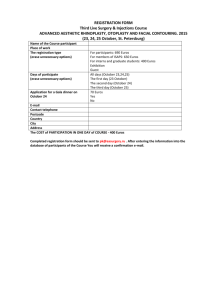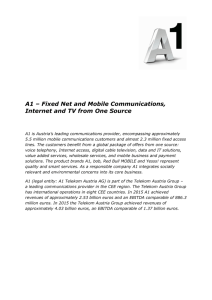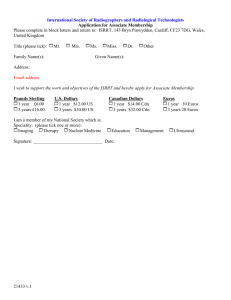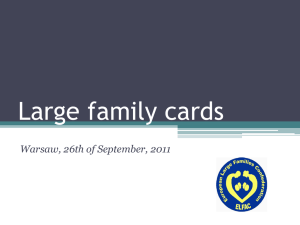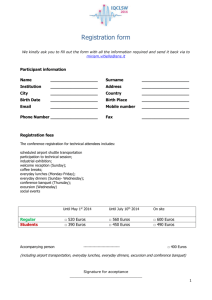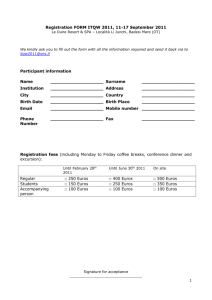2007, 30 months 352 658 €, Leonardo 75
advertisement
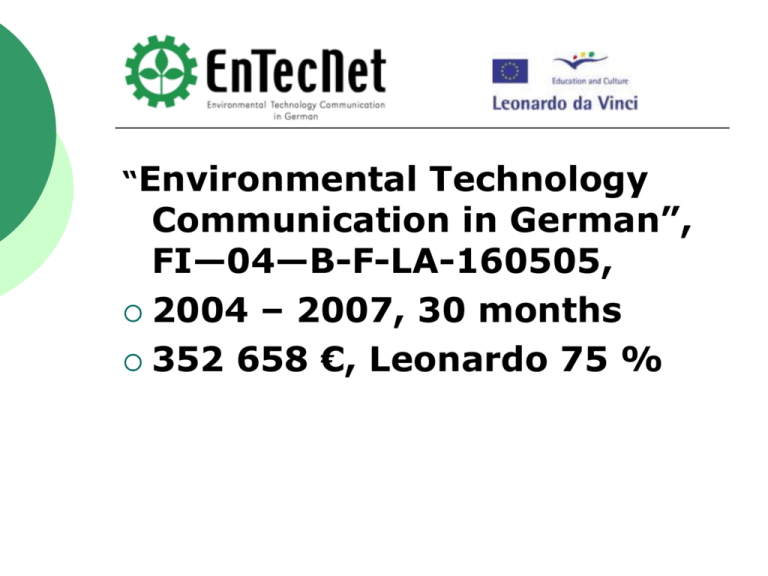
“Environmental Technology Communication in German”, FI—04—B-F-LA-160505, 2004 – 2007, 30 months 352 658 €, Leonardo 75 % Combined German Language and Environmental Technology (web-based and contact learning) Kaisa Nikku, LUT Partnership, objectives, outcomes of the project Pauli Kudel, HUT Pegagogic approach Jörg Langwaldt, LUT Environmental scope, content, needs Partnership The partnership combines the complementary competencies and experience required for the successful completion of the project: Long and solid experience in Leonardo language projects: PINE, DEWECO, FORESTLANG, ILEGEFOS, DEUMA, LOGOS GAIAS pedagogic content development and training competence; tools development and adaptation of the Telos Language Partner Suite; pedagogic evaluation competence; Environmental Technology expertise and access to authentic materials; Project cycle management skills Partners of EnTecNet Finland Lappeenranta University of Technology, Coordinator Helsinki University of Technology Contractor, France Chamber of Commerce and Industry of the Jura, Lon-leSaunier Germany University of Tübingen, Applied English Linguistics, Tübingen Association for the Promotion of International Environment Technology Transfer, Leipzig (social partner) Partners of EnTecNet Austria Federal Ministry for Economic Affairs and Labour, Vienna (social partner) Romania University of Agronomic Sciences and Veterinary Medicine, Bucharest Authors group Administrational group Aims of EnTecNet Reinforcement of vocational German language training in the field of ET with the aim of increasing the mobility of people working in the ET sector by means of: a clear focus on communication-oriented, work-related language learning and teaching based on authentic materials development of a multimedia language training package for offline (CD-ROM) and online (Internet) use teachers’ autonomy: teachers are enabled to further adapt and customise the (offline and online) multimedia learning contents a pedagogic approach of blended language learning Background need for education in vocational German for ET lack of work-related quality study materials lack of interactive training tools Multimedia language training package based on Telos Language Partner learning platform learners of intermediate and advanced level work-related communication-oriented authentic material Themes air water soil biocoenosis urban areas rural areas Material format video situations dialogues texts different exercise types Pilot courses blended language learning scenarios classroom teaching or/and selfstudy material evaluation a) professional side b) pedagogical side Results achieved through development of new learning medium blended learning work-embedded language learning teacher “autonomy” networking in pedagogical and international groups networking tools between the partners created during the pilot courses For whom? decision-makers in environmental offices and in various companies environmental protection officers PR officers researchers teachers students Ready for use in 2007 a multimedia language training package for vocational German for ET suitable for offline (CD-ROM) and online (Internet) use Strategies of the European Commission to improve and restore the environment, thus assuring the standard of living in EU to protect the natural resources and ecosystems to increase renewable energy production to increase EU’s competitiveness and position in ET Water framework directive Environmental Technologies Action Plan (ETAP) “Information Communication Technology” to increase foreign language skills Eco-industry: a booming sector EU’s Eco-industries supplies 50% of the world market for environmental technologies and services World market: 550 billion euros in 2004 (32% by EU) estimated 740 billion euros by 2010 Annual turnover: EU-25 183 billion euros New EU members 10 billion euros Germany 57 billion euros Austria 2.5 (7.5) billion euros The European Commission expects 10% annual growth in Middle and East Europe in the solid waste treatment market In East Europe needs of about 120 billion euros for the remediation of contaminated environment Friedemann Allgayer, European Commission officer, 2004 ET Market in Middle and East Europe New EU members: estimated needs for environmental technology: 240 billion euros Estimated financial needs of new EU-members in billion euros: Poland 22-42 Hungary 4-10 Slovakia 5 Czech Republic 7-9 Estonia 4 Slovenian 3 Latvia 2 Lithuania 2 Cyprus 1 (Rumania 27) ET - German speaking countries Germany and Austria are leading countries in the area of Environmental Protection and Technology. USA 23% Germany 17% Japan 12% Austria 2% 1 out of 5 ET-products come from Germany Germany and Austria have a common border with several new EU-member countries in East Europe Eco-industry and EU labor market Narrow definition including resource management and renewable energy: Wider definition including waste recycling, nature and landscape protection, and ecological renovation of urban areas: 1.7 million jobs up to 3.5 million jobs Margot Wallström, European Commissioner for the Environment Germany: over 1.5 million employees are working in the ET sector, thus 3.5 % of all employees. Austria: about 150.000 employees in ET sector Urban areas Air protection Solid waste Rural areas Soil remediation Water protection Renewable Energy Wastewater treatment Soil Concept of EnTecNet EnTecNet and the EC strategies Increased language competence Facilitating lifelong learning with ICT Environmental protection and technology including renewable energies Networking of professionals Working towards making EU the most dynamic business region
